The Implication of Injection Locations in an Axisymmetric Cavity-Based Scramjet Combustor
Abstract
1. Introduction
2. Numerical Methods
2.1. Geometry Modeling
2.1.1. Computational Domain
2.1.2. Boundary Conditions
2.1.3. Grid Independence Study
3. Results and Discussion
3.1. Validation
3.2. Flow Field Analysis
3.3. Wall Static Pressure
3.4. Mass Fraction of H2 and H2O
3.5. Temperature Distribution
3.6. Combustion Efficiency
3.7. Total Pressure Loss
4. Conclusions
- The angled transverse injection upstream of the cavity provides a higher wall pressure profile in the cavity region, indicating that the shock waves generated from the injection location interact with the core flow to create a shock train in the cavity region which creates a compressive zone compared to other cases. The transverse injection at the bottom wall of the cavity provides higher wall pressures in the cavity region compared to the fore wall injection schemes.
- The temperature contour reveals that the upstream and bottom wall injections of the cavity provide higher temperature distribution within the entire cavity, indicating that complete combustion of the hydrogen-air mixture is achieved compared to the injection at the fore wall of the cavity.
- The almost complete combustion is achieved within an axial distance of approximately 110 mm from the combustor inlet by the upstream and bottom wall injection of the cavity.
- The total pressure loss across the combustor is almost identical for all the injection schemes within a marginal variation of less than 5%. From the above observations, the upstream angled injection and bottom wall injection of the cavity provide an enhancement in combustion and flame-holding capabilities with optimum total pressure loss compared to the other injection schemes. These results would be an encouraging pointer for the circular scramjets of hypersonic propulsion applications. The performances of the injection schemes under varying injection pressures and fuel equivalence ratios are considered for future studies.
Author Contributions
Funding
Institutional Review Board Statement
Informed Consent Statement
Data Availability Statement
Conflicts of Interest
Nomenclature
| Ma | Mach number |
| ρ | Density (kg/m3) |
| p | Static pressure (Pascal) |
| P | Total pressure (Pascal) |
| t | Static temperature (K) |
| T | Total temperature (K) |
| k | turbulence kinetic energy |
| ω | specific dissipation rate |
| YH2 | Mass fraction of hydrogen |
| YO2 | Mass fraction of oxygen |
| YH2O | Mass fraction of water |
References
- Chang, J.; Zhang, J.; Bao, W.; Yu, D. Research progress on strut-equipped supersonic combustors for scramjet application. Prog. Aerosp. Sci. 2018, 103, 1–30. [Google Scholar] [CrossRef]
- Li, L.q.; Huang, W.; Yan, L.; Li, S.b. Parametric effect on the mixing of the combination of a hydrogen porthole with an air porthole in transverse gaseous injection flow fields. Acta Astronaut. 2017, 139, 435–448. [Google Scholar] [CrossRef]
- Liu, Q.; Baccarella, D.; Hammack, S.; Lee, T.; Carter, C.D.; Do, H. Influences of freestream turbulence on flame dynamics in a supersonic combustor. AIAA J. 2017, 55, 913–918. [Google Scholar] [CrossRef]
- Richard, J.W.; MacKay, J.S. An Analysis of Ramjet Engines Using Supersonic Combustion; National Advisory Committee for Aeronautics Collection Tech Note 4386; NACA: Washington, DC, USA, 1952.
- Seleznev, R.K.; Surzhikov, S.T.; Shang, J.S. A review of the scramjet experimental data base. Prog. Aerosp. Sci. 2019, 106, 43–70. [Google Scholar] [CrossRef]
- Ren, Z.; Wang, B.; Xiang, G.; Zhao, D.; Zheng, L. Supersonic spray combustion subject to scramjets: Progress and challenges. Prog. Aerosp. Sci. 2019, 105, 40–59. [Google Scholar] [CrossRef]
- Athithan, A.A.; Jeyakumar, S.; Sczygiol, N.; Urbanski, M. The Combustion Characteristics of Double Ramps in a Strut-Based Scramjet Combustor. Energies 2021, 14, 831. [Google Scholar] [CrossRef]
- Ingenito, A.; Bruno, C. Physics and regimes of supersonic combustion. AIAA J. 2010, 48, 515–525. [Google Scholar] [CrossRef]
- Ingenito, A.; Bruno, C. Mixing and combustion in supersonic reactive flows. In Proceedings of the 44th AIAA/ASME/SAE/ASEE Joint Propulsion Conference and Exhibit, Hartford, CT, USA, 21–23 July 2008. AIAA Paper: 2008-4574. [Google Scholar]
- Ingenito, A.; De Flora, M.G.; Bruno, C.; Giacomazzi, E.; Steelant, J. A Novel Model of Turbulent Supersonic Combustion: Development and Validation. In Proceedings of the 42nd AIAA/ASME/SAE/ASEE Joint Propulsion Conference and Exhibit, Sacramento, CA, USA, 9–12 July 2006; pp. 423–436. [Google Scholar]
- Gruber, M.R.; Nejadt, A.S.; Chen, T.H.; Dutton, J.C. Mixing and penetration studies of sonic jets in a Mach 2 freestream. J. Propuls. Power 1995, 11, 315–323. [Google Scholar] [CrossRef]
- Seiner, J.M.; Dash, S.M.; Kenzakowski, D.C. Historical survey on enhanced mixing in scramjet engines. J. Propuls. Power 2001, 17, 1273–1286. [Google Scholar] [CrossRef]
- Ogawa, H. Mixing Characteristics of Inclined Fuel Injection via Various Geometries for Upstream-Fuel-Injected Scramjets. J. Propuls. Power 2015, 31, 1551–1566. [Google Scholar] [CrossRef]
- Ben Yaker, A.; Hanson, R.K. Experimental Investigation of Flame-Holding Capability of Hydrogen Transverse Jet in Supersonic Cross Flow. Symp. Int. Comb. 1998, 27, 2173–2180. [Google Scholar] [CrossRef]
- Ben-Yakar, A. Experimental Investigation of Mixing and Ignition of Transverse Jets in Supersonic Cross flows. Ph.D. Thesis, Stanford University, Stanford, CA, USA, December 2000. [Google Scholar]
- Xing, F.; Zhao, M.M.; Zhang, S. Simulations of a cavity based two-dimensional scramjet model. In Proceedings of the 18th Australas Fluid Mechanics Conference AFMC, Launceston, Australia, 3–7 December 2012. [Google Scholar]
- Ortwerth, P.J.; Mathur, A.B.; Vinogradov, V.A.; Grin, V.T.; Goldfeld, M.A.; Starov, A.V. Experimental and numerical investigation of hydrogen and ethylene combustion in a Mach 3-5 channel with a single injector. In Proceedings of the 32nd AIAA/ASME/SAE/ASEE Joint Propulsion Conference Exhibit, Lake Buena Vista, FL, USA, 1–3 July 1996. [Google Scholar]
- Owens, M.G.; Tehranian, S.; Segal, C.; Vinogradov, V.A. Flame-Holding Configurations for Kerosene Combustion in a Mach 1.8 Airflow. J. Propuls. Power 1998, 14, 456–461. [Google Scholar] [CrossRef]
- Vinogradov, V.A.; Kobigsky, S.A.; Petrov, M.D. Experimental Investigation of Kerosene Fuel Combustion in Supersonic Flow. J. Propuls. Power 1995, 11, 130–134. [Google Scholar] [CrossRef]
- Panigrahi, C.; Vaidyanathan, A.; Nair, M.T. Effects of subcavity in supersonic cavity flow. Phys. Fluids 2019, 31, 036101. [Google Scholar] [CrossRef]
- Wang, H.; Wang, Z.; Sun, M.; Qin, N. Large eddy simulation of a hydrogen-fueled scramjet combustor with dual cavity. Acta Astronaut. 2015, 108, 119–128. [Google Scholar] [CrossRef]
- Barnes, F.W.; Tu, Q.; Segal, C. Fuel-air mixing experiments in a directly fueled supersonic cavity flameholder. J. Propuls. Power 2016, 32, 305–310. [Google Scholar] [CrossRef]
- Lin, K.; Tam, C.; Boxx, I.; Carter, C.; Jackson, K.; Lindsey, M. Flame characteristics and fuel entrainment inside a cavity flame holder in a scramjet combustor. In Proceedings of the 43rd AIAA/ASME/SAE/ASEE Joint Propulsion Conference & Exhibit, Cincinnati, OH, USA, 8–11 July 2007. [Google Scholar] [CrossRef]
- Wang, H.; Wang, Z.; Sun, M.; Qin, N. Combustion characteristics in a supersonic combustor with hydrogen injection upstream of cavity flameholde. Proc. Combust. Inst. 2013, 34, 2073–2082. [Google Scholar] [CrossRef]
- Gruber, M.R.; Donbar, J.M.; Carter, C.D.; Hsu, K.-Y. Mixing and Combustion Studies Using Cavity-Based Flameholders in a Supersonic Flow. J. Propuls. Power 2004, 20, 769–778. [Google Scholar] [CrossRef]
- Yu, K.H.; Wilson, K.J.; Schadow, K.C. Effect of Flame-Holding Cavities on Supersonic-Combustion Performance. J. Propuls. Power 2001, 17, 1287–1295. [Google Scholar] [CrossRef]
- Zhang, J.; Chang, J.; Tian, H.; Li, J.; Bao, W. Flame Interaction Characteristics in Scramjet Combustor Equipped with Strut/Wall Combined Fuel Injectors. Combust. Sci. Technol. 2020, 192, 1863–1886. [Google Scholar] [CrossRef]
- Kim, C.H.; Jeung, I.S. Forced combustion characteristics related to different injection locations in unheated supersonic flow. Energies 2019, 12, 1746. [Google Scholar] [CrossRef]
- Zhang, J.; Chang, J.; Ma, J.; Wang, Y.; Bao, W. Investigations on flame liftoff characteristics in liquid-kerosene fueled supersonic combustor equipped with thin strut. Aerosp. Sci. Technol. 2019, 84, 686–697. [Google Scholar] [CrossRef]
- Jeong, E.; O’Byrne, S.; Jeung, I.S.; Houwing, A.F.P. The effect of fuel injection location on supersonic hydrogen combustion in a cavity-based model scramjet combustor. Energies 2020, 13, 193. [Google Scholar] [CrossRef]
- Li, L.Q.; Huang, W.; Fang, M.; Shi, Y.L.; Li, Z.H.; Peng, A.P. Investigation on three mixing enhancement strategies in transverse gaseous injection flow fields: A numerical study. Int. J. Heat Mass Transf. 2019, 132, 484–497. [Google Scholar] [CrossRef]
- Magnussen, B.F.; Hjertager, B.H. On mathematical models of turbulent combustion with special emphasis on soot formation and combustion. Symp. Combust. Inst. 1976, 16, 719–729. [Google Scholar] [CrossRef]
- Jeyakumar, S.; Assis, S.M.; Jayaraman, K. Experimental study on the characteristics of axisymmetric cavity actuated supersonic flow. J. Aerosp. Eng. 2017, 231, 2570–2577. [Google Scholar] [CrossRef]
- Assis, S.M.; Suppandipillai, J.; Kandasamy, J. Transverse Injection Experiments within an Axisymmetric Scramjet Combustor. Int. J. Turbo Jet-Engines 2019. [Google Scholar] [CrossRef]
- Relangi, N.; Garimella, D.; Jayaraman, K.; Venkatesan, J.; Jeyakumar, S.; Ingenito, A. Numerical simulations of axisymmetric aft wall angle cavity in supersonic combustion ramjets. In Proceedings of the AIAA Propuls, Energy 2020 Forum, Virtual Event, 24–28 August 2020; pp. 1–15. [Google Scholar]
- Ben-Yakar, A.; Hanson, R.K. Cavity Flame-Holders for Ignition and Flame Stabilization in Scramjets: An Overview. J. Propuls. Power 2001, 17, 869–877. [Google Scholar] [CrossRef]
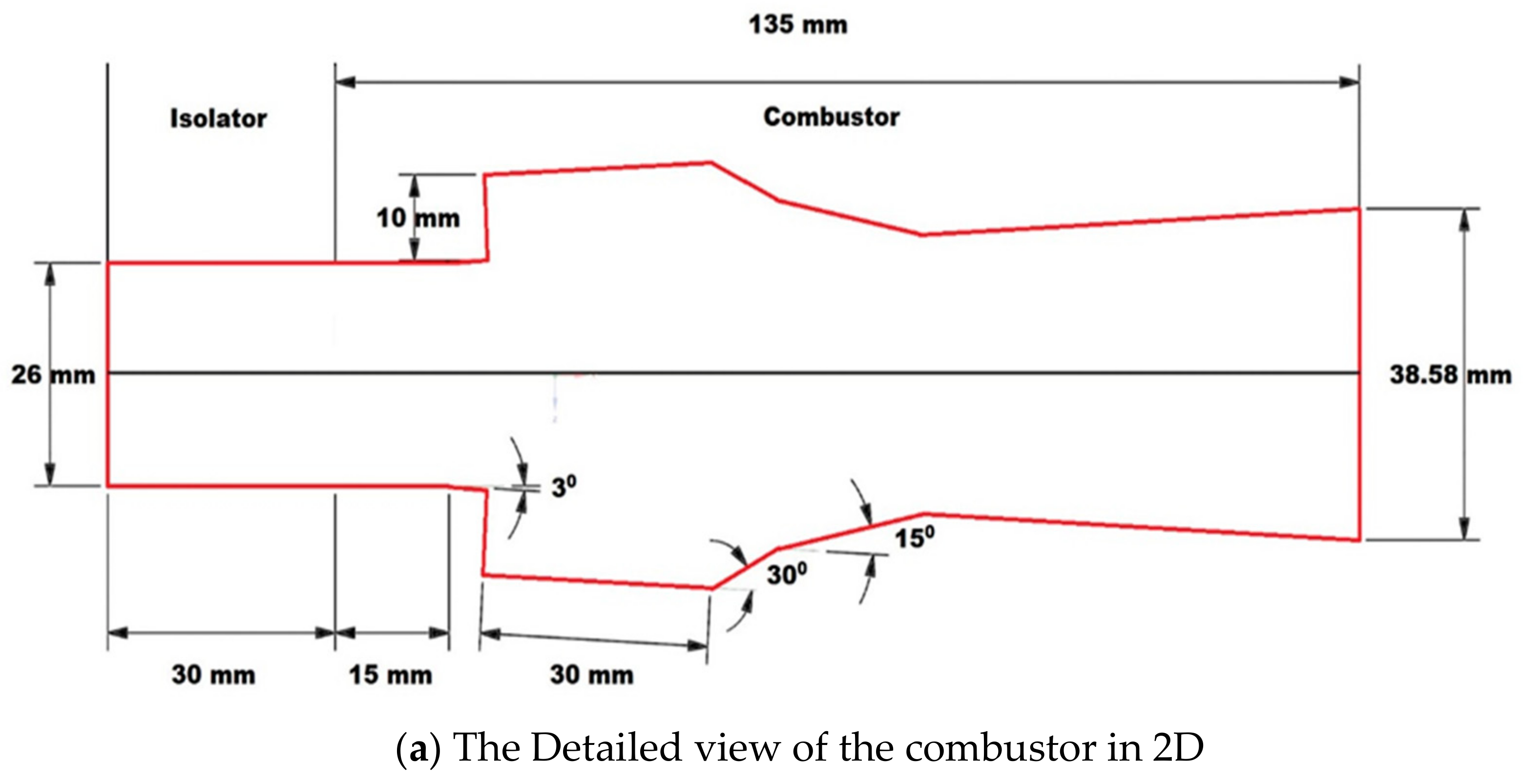
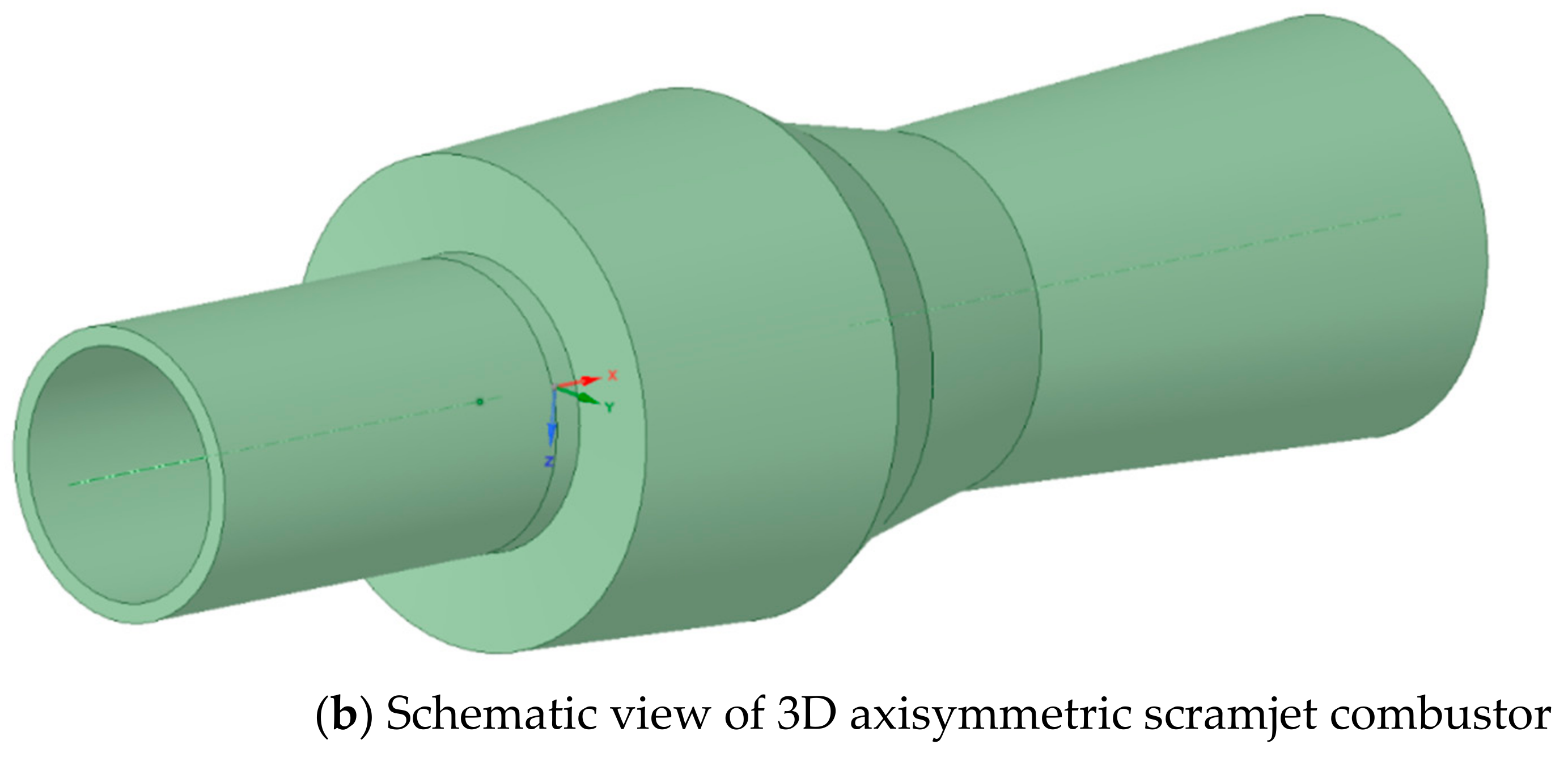
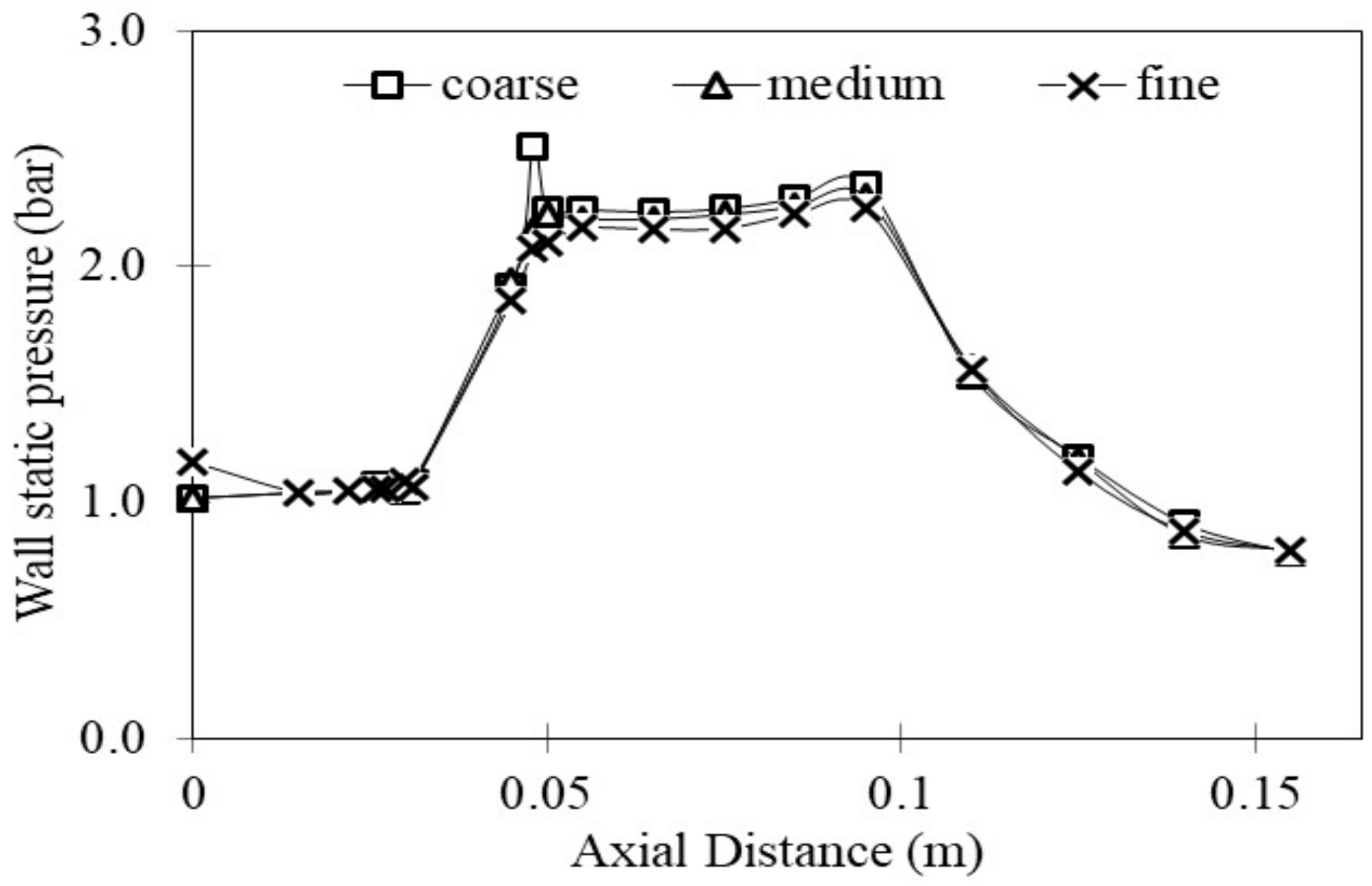
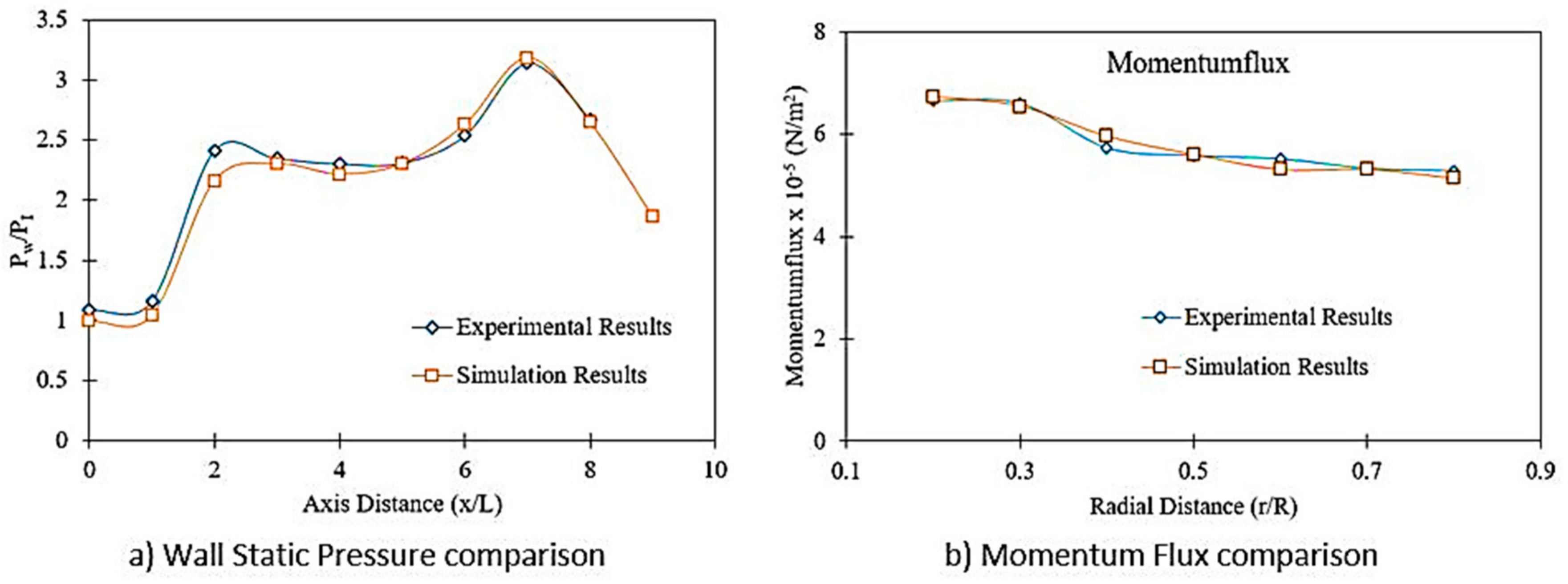
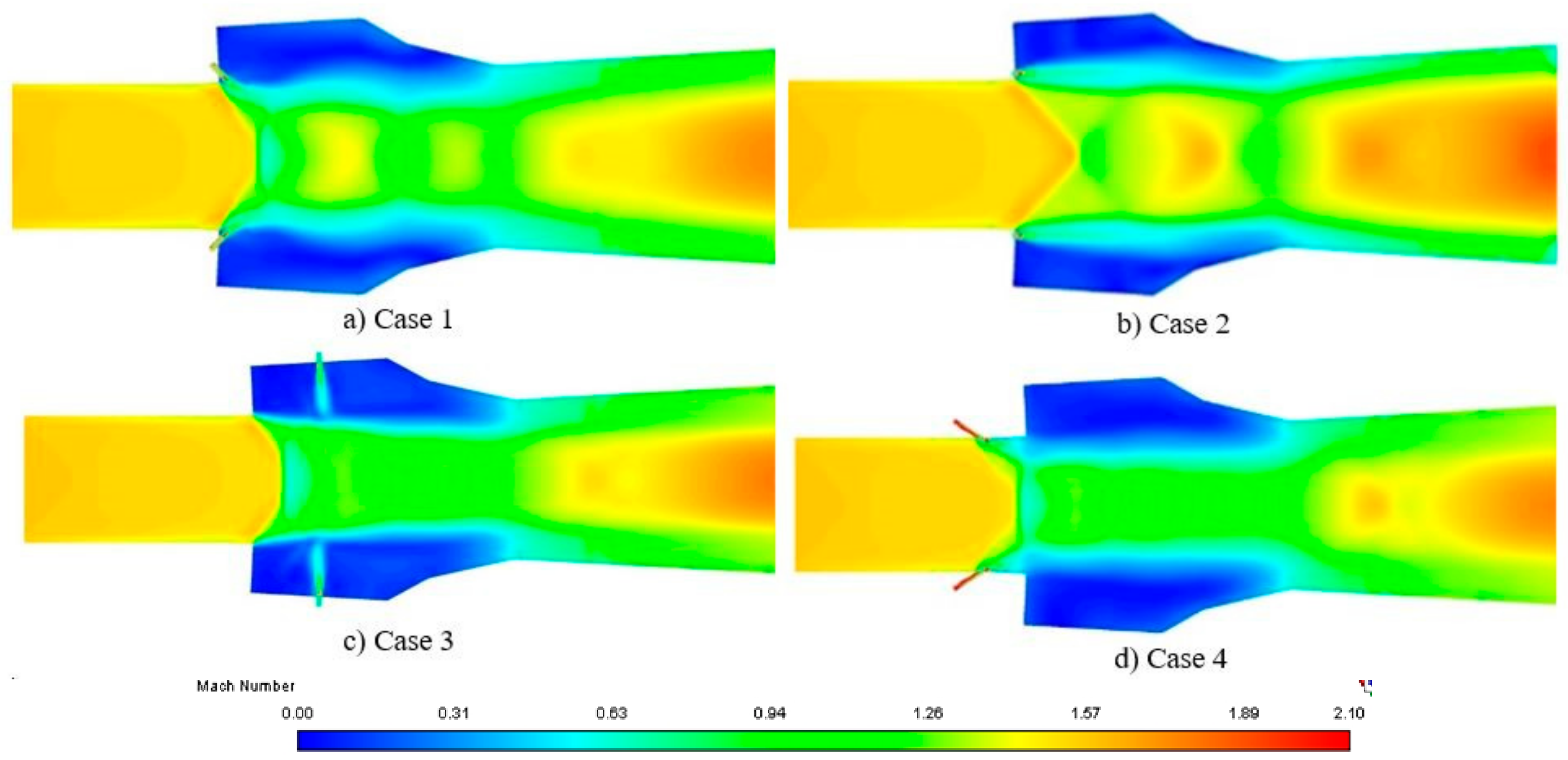


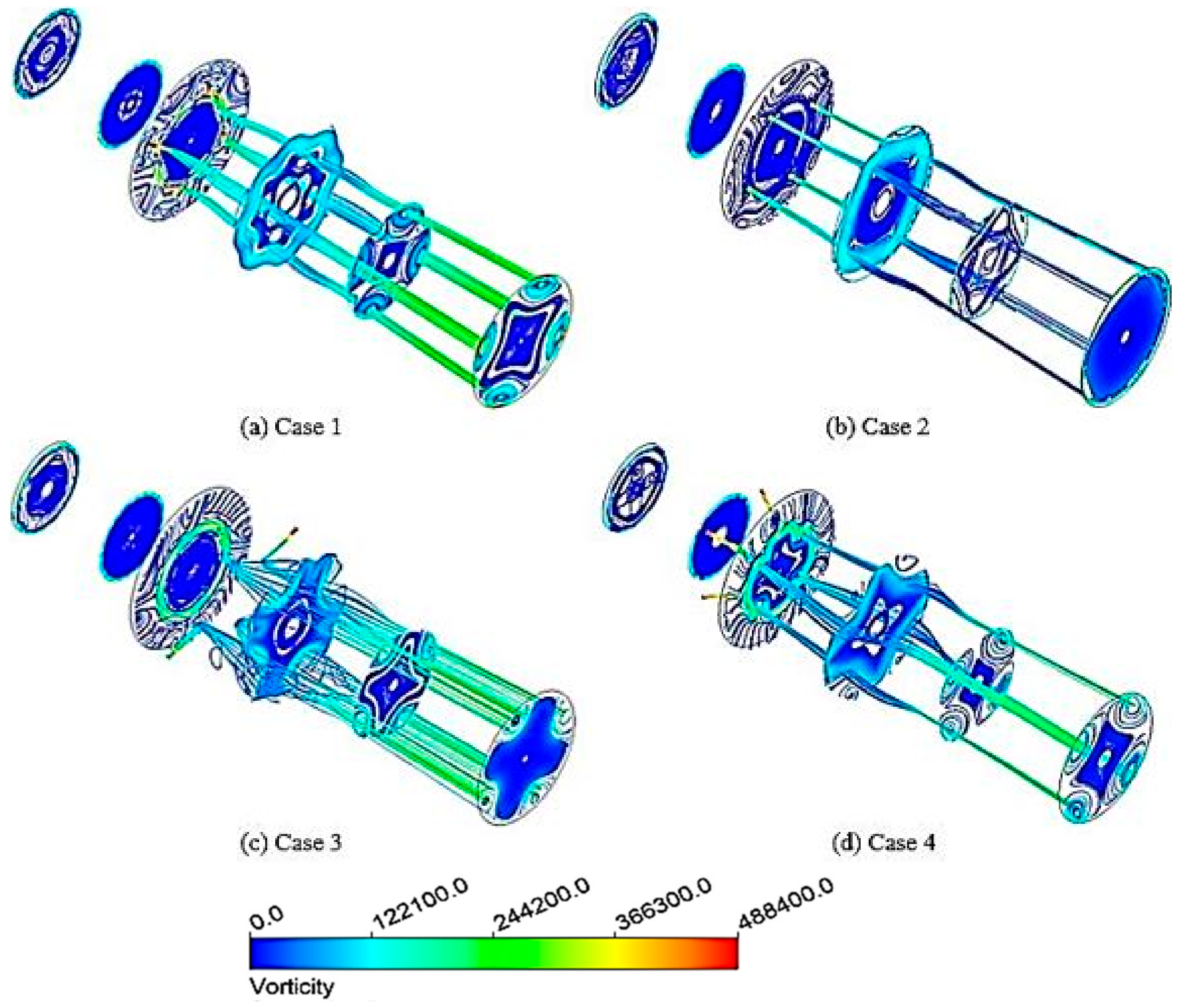
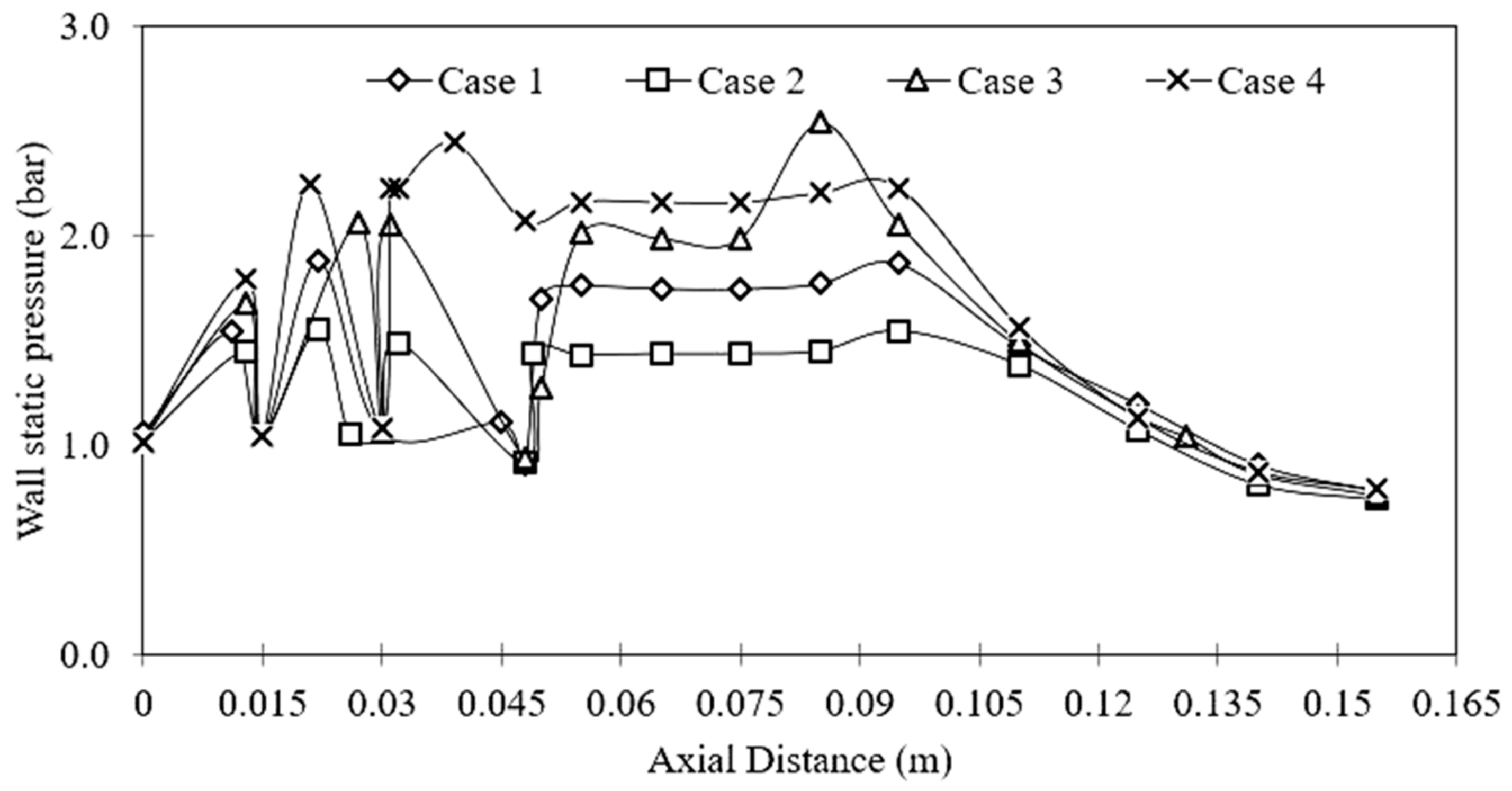
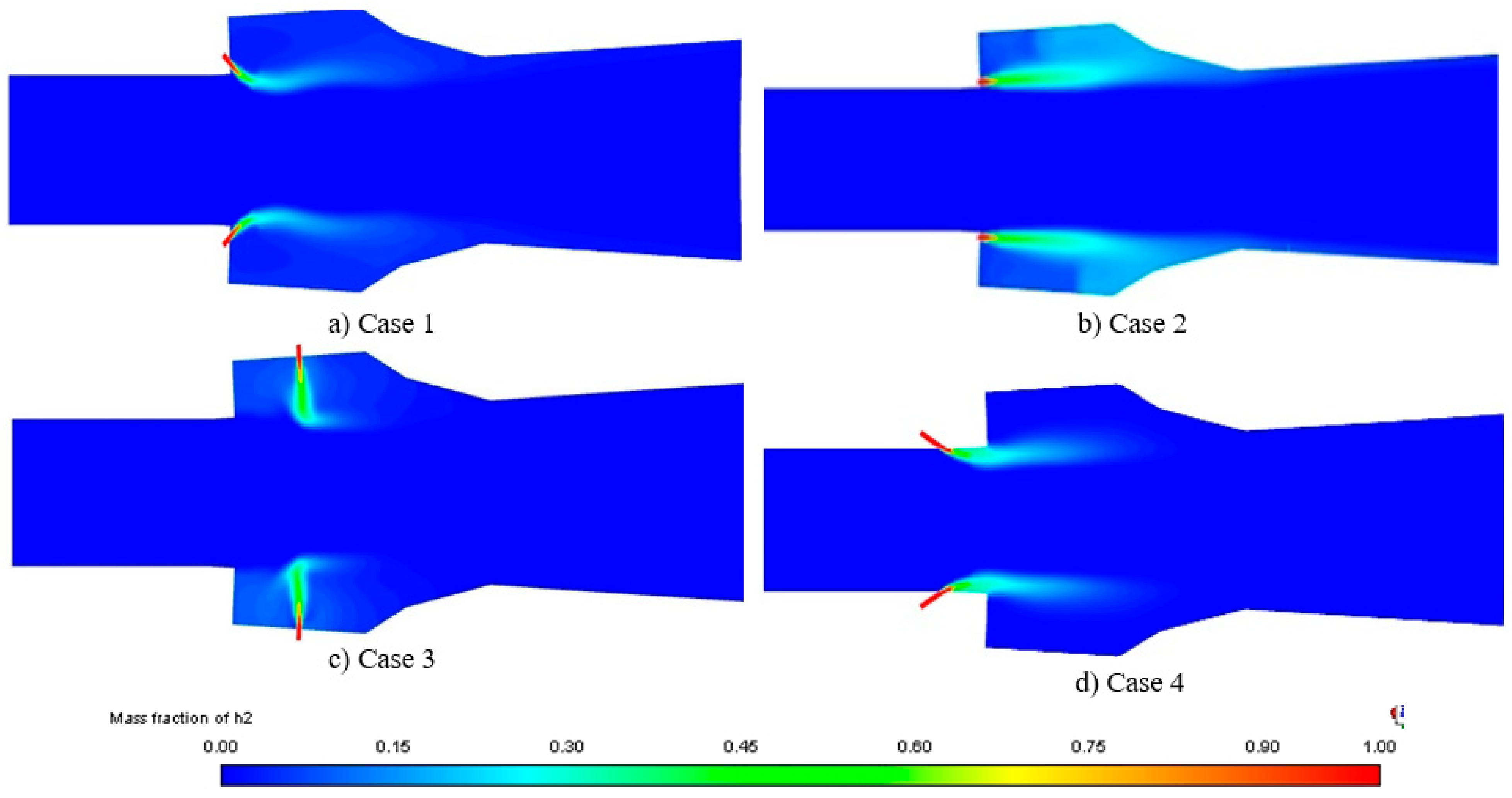



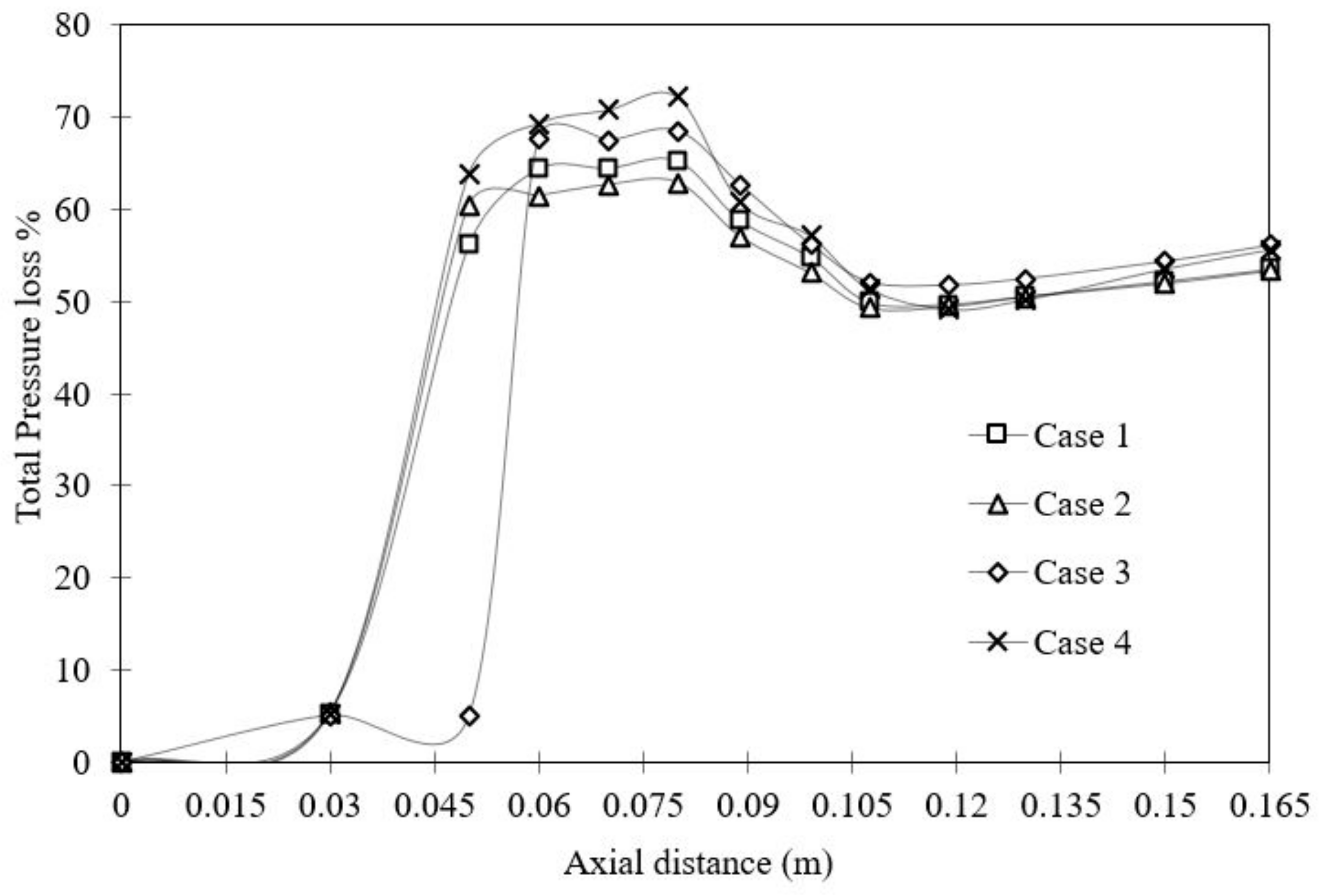
| Variable | Air | H2 |
|---|---|---|
| Ma | 1.8 | 1.0 |
| T (K) | 540 | 300 |
| P (Pascal) | 480,000 | 700,000 |
| t (K) | 332 | 250 |
| P (pascal) | 100,000 | 100,000 |
| ρ (kg/m3) | 1.04 | 0.097 |
| Yo2 | 0.232 | 0 |
| YH2 | 0 | 1 |
| YH2O | 0.032 | 0 |
Publisher’s Note: MDPI stays neutral with regard to jurisdictional claims in published maps and institutional affiliations. |
© 2021 by the authors. Licensee MDPI, Basel, Switzerland. This article is an open access article distributed under the terms and conditions of the Creative Commons Attribution (CC BY) license (https://creativecommons.org/licenses/by/4.0/).
Share and Cite
Relangi, N.; Ingenito, A.; Jeyakumar, S. The Implication of Injection Locations in an Axisymmetric Cavity-Based Scramjet Combustor. Energies 2021, 14, 2626. https://doi.org/10.3390/en14092626
Relangi N, Ingenito A, Jeyakumar S. The Implication of Injection Locations in an Axisymmetric Cavity-Based Scramjet Combustor. Energies. 2021; 14(9):2626. https://doi.org/10.3390/en14092626
Chicago/Turabian StyleRelangi, Naresh, Antonella Ingenito, and Suppandipillai Jeyakumar. 2021. "The Implication of Injection Locations in an Axisymmetric Cavity-Based Scramjet Combustor" Energies 14, no. 9: 2626. https://doi.org/10.3390/en14092626
APA StyleRelangi, N., Ingenito, A., & Jeyakumar, S. (2021). The Implication of Injection Locations in an Axisymmetric Cavity-Based Scramjet Combustor. Energies, 14(9), 2626. https://doi.org/10.3390/en14092626







